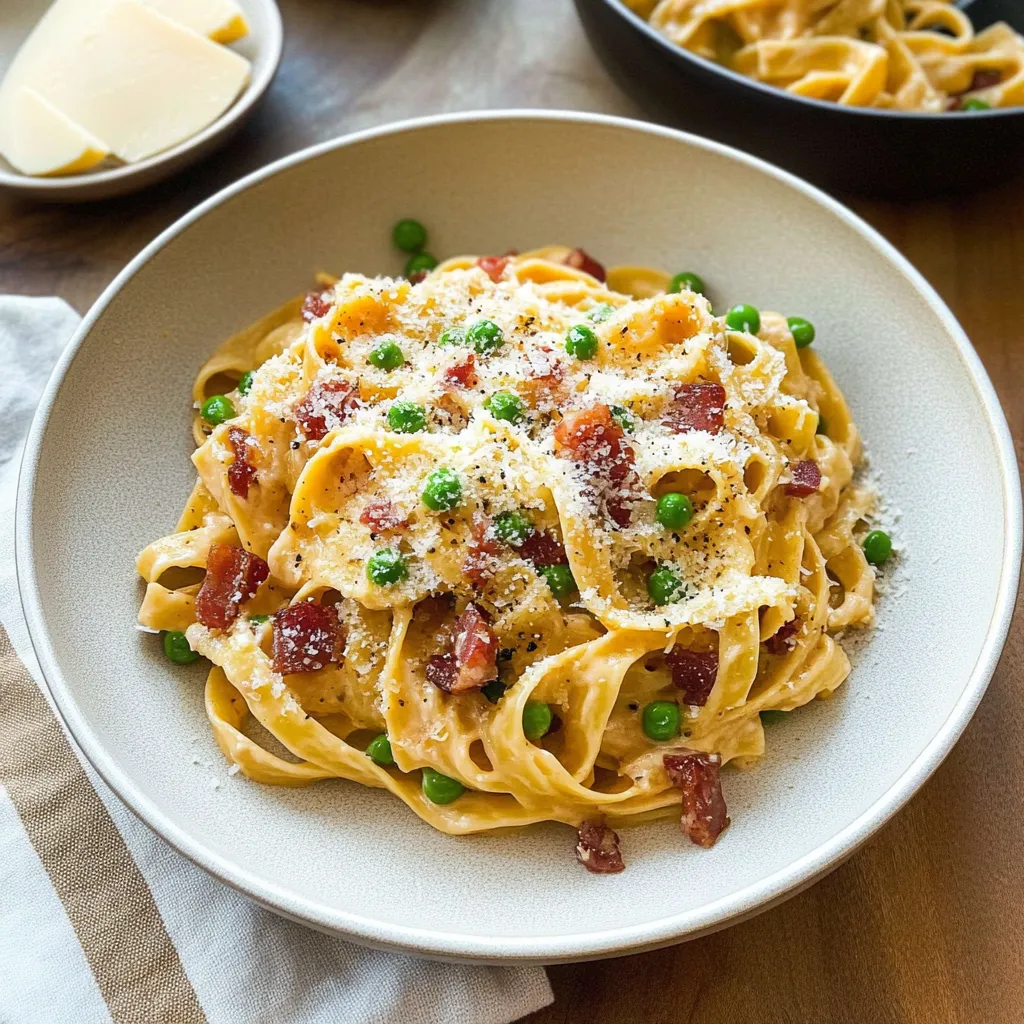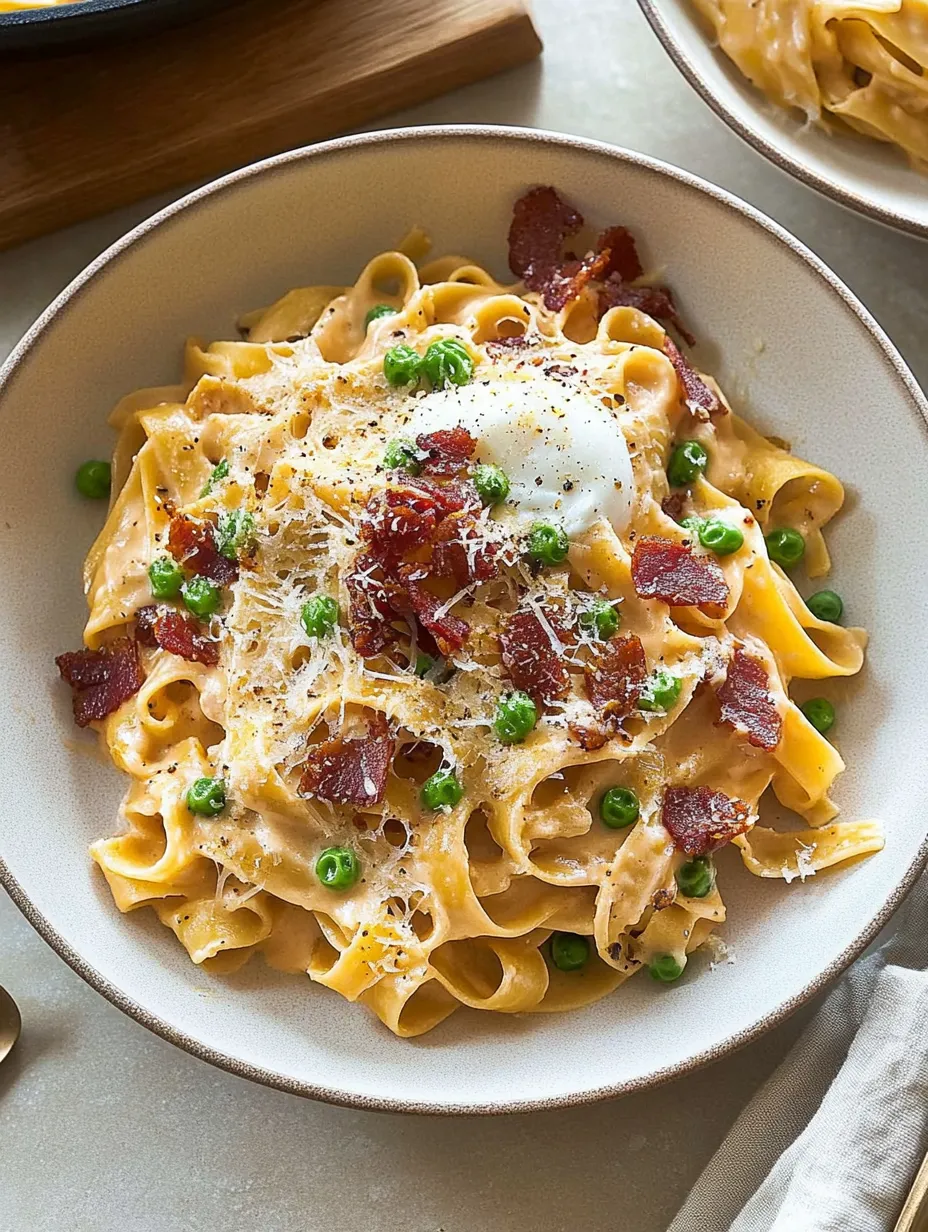 Pin it
Pin it
This carbonara pasta is my absolute go-to when I want to impress someone without spending hours in the kitchen. I learned the basic technique during a trip to Rome years ago, and I've been tweaking it ever since to get that perfect silky texture. There's something magical about how a few simple ingredients transform into this luxurious sauce that coats every strand of pasta. It's become my signature dish for date nights at home - nothing says "I care" like a perfectly executed carbonara!
My Italian-American friend Marco, who's super picky about pasta, actually asked for seconds when I made this for dinner last month! My neighbor brought over a bottle of wine last week specifically requesting I make "that amazing carbonara" to go with it. There's something about the combination of simple ingredients that creates something so much more special than the sum of its parts.
Simple Ingredients
- Pasta: Traditional carbonara uses spaghetti, but I've made it with bucatini for a chewier texture or rigatoni when I want the sauce to get caught inside the tubes. Whatever shape you choose, make sure to cook it just until al dente - it will continue cooking slightly when you add it to the pan.
- Pancetta: The authentic Italian choice that adds a wonderful salty-porky flavor without overwhelming the dish like bacon sometimes can. I've used bacon in a pinch (who hasn't?), but pancetta has a cleaner flavor that lets the eggs and cheese shine through. Ask the deli counter to cut it into a thick slice so you can dice it yourself.
- Eggs: These create the creamy magic that makes carbonara special. I use large eggs at room temperature so they don't seize up when they hit the hot pasta. The first time I made this, I used cold eggs straight from the fridge and ended up with scrambled egg pasta - not the silky sauce I was hoping for!
- Cheese: The combination of sharp Pecorino Romano and nutty Parmesan creates the perfect flavor balance. Pre-grated stuff in a can just won't work here - buy a block and grate it yourself for that perfect melt. I've made it with just Parmesan when that's all I had, and it's still delicious, just not quite as complex.
- Pasta water: Don't forget to save some before draining! This starchy water is liquid gold that helps create that silky texture and bind the sauce to the pasta. I've forgotten this step before and had to quickly add plain hot water, which works in an emergency but doesn't have the same binding power.
 Pin it
Pin it
Step-by-Step Instructions
- Perfect pasta cooking
- Getting that ideal al dente texture starts with proper boiling. Always salt your pasta water generously - it should taste like the sea. I start testing the pasta about 2 minutes before the package directions say it should be done. You want it slightly firm at the center as it will continue cooking when you toss it with the sauce. My first few attempts at carbonara had mushy pasta because I overcooked it in the initial boiling stage, not realizing it would cook more in the final toss.
- Pancetta crisping
- Achieving those perfect crispy bits takes patience. Start with a cold pan and cook the diced pancetta slowly so it renders its fat properly without burning. I aim for most pieces to be crispy with a few chewy bits for texture contrast. The rendered fat becomes part of your sauce, so using a good quality pancetta makes a difference in the final flavor. When adding the garlic, I keep a close eye on it - 30 seconds is perfect to become fragrant without burning and turning bitter.
- Egg mixture preparation
- Creating that silky sauce begins with thorough mixing. I whisk the eggs and cheese together completely before the pasta is even done cooking. This ensures everything is ready for the critical moment of sauce creation. A good grind of black pepper is traditional and adds that signature speckled look to authentic carbonara. I sometimes add a pinch of red pepper flakes too if I want a bit of heat.
- The crucial heat management
- Mastering carbonara is all about temperature control. The trickiest part is adding the egg mixture without scrambling the eggs. I take the pan completely off the heat before adding the hot pasta, then give it about 30 seconds to cool slightly before pouring in the egg mixture. Constant tossing keeps any one part from getting too hot. The residual heat from the pasta and pan should be just enough to cook the eggs into a creamy sauce without scrambling.
- Pasta water wizardry
- Achieving that perfect sauce consistency takes practice. I add the reserved pasta water a little at a time while tossing everything together. How much you need varies every time depending on how starchy your pasta water is and how quickly you work. The sauce should coat the pasta in a silky layer without pooling in the bottom of the bowl. If it looks too tight or thick, add a splash more water; if it's too loose, give it a moment to thicken up.
- Immediate serving
- Enjoying carbonara at its best means eating it right away. This is not a dish that improves with sitting! I warm the serving bowls while the pasta cooks by filling them with hot water, then emptying and drying them just before serving. This keeps the carbonara from cooling too quickly, which can make the sauce tighten up. I always have the table set and everyone ready to eat before I even start cooking the pasta.
My first attempt at carbonara was actually a disaster - I had the heat too high and ended up with pasta scrambled eggs. I've gradually refined my technique over about a dozen attempts, learning that the residual heat from the pasta and pan is exactly what's needed - no more, no less. I've also experimented with different cheese ratios and found that a slight Pecorino dominance gives the best tangy kick that balances the richness of the eggs and pancetta.
Serving Style
This beautiful pasta deserves proper presentation! I serve it in warmed shallow bowls, twirling the pasta into a neat mound with tongs. A little extra grated cheese goes on top, along with a fresh grind of black pepper and sometimes a few small pieces of reserved crispy pancetta for visual appeal. It pairs beautifully with a simple arugula salad dressed with lemon and olive oil to cut through the richness. For wine, a crisp white like Pinot Grigio or a light-bodied red like Chianti works perfectly.
Flavor Variations
This classic carbonara can be adapted in subtle ways while respecting its simplicity. In spring, I sometimes add a handful of fresh peas right at the end - not traditional, but the pop of sweetness is lovely. For a deeper flavor, try adding a splash of dry white wine to the pancetta and reducing it before adding the pasta. My herb-loving friend enjoys a sprinkle of fresh parsley on top for color and freshness. And while purists might object, a little minced shallot sautéed with the pancetta adds a subtle sweetness that I quite enjoy.
Quick Tips
This pasta is definitely best enjoyed immediately after cooking when the sauce is at its silkiest. If you do have leftovers (which is rare in my house!), reheat them very gently with a splash of water in a covered pan over low heat. The sauce won't be quite as creamy, but it will still be delicious. All the components can be prepared ahead - cheese grated, pancetta diced, eggs whisked - so that when hunger strikes, dinner is just minutes away.
 Pin it
Pin it
I created this carbonara recipe after a memorable meal in a tiny trattoria in Rome's Trastevere neighborhood. The chef explained the technique to me in broken English, emphasizing the importance of "no cream, never cream!" I've been perfecting it ever since, and while it might not be exactly like that magical Roman version, it brings me back to that evening with every bite. It's the perfect example of how a handful of simple ingredients, treated with care and respect, can create something truly extraordinary.
Frequently Asked Questions
- → How do I prevent the eggs from scrambling?
- The key is to remove the pan from heat before adding the egg mixture. The residual heat from the pasta will gently cook the eggs without scrambling them. Keep tossing quickly and add pasta water as needed to create a smooth sauce.
- → Can I use bacon instead of pancetta?
- Yes! Bacon makes a great substitute for pancetta, though it has a stronger smoky flavor. For the closest match to traditional carbonara, look for bacon that's not heavily smoked.
- → Is there a vegetarian version of carbonara?
- You can make a vegetarian version by omitting the pancetta and adding sautéed mushrooms for umami flavor. Some also like to add peas or asparagus for extra texture and nutrition.
- → Why is my sauce too thick/thin?
- If your sauce is too thick, add more pasta water a tablespoon at a time until it reaches your desired consistency. If it's too thin, continue tossing the pasta - it will thicken as it cools slightly.
- → Can I add cream to my carbonara?
- Traditional carbonara doesn't include cream - the creamy texture comes from the eggs and cheese. However, some modern variations do include a splash of cream for extra richness.
